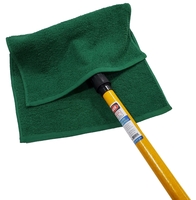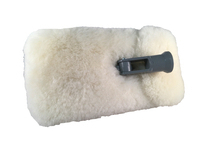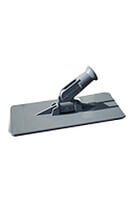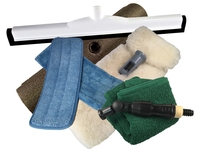Blog
Survive a Disaster
After a recent newsletter centering around the necessity to pull together survival items in case of a disaster, several people wrote and ask me for a list of the products I've found. They know I spend a great deal of time researching everything before I either add it to my Mary Moppins product line or for personal use.
This is my list and it is a long blog post, so please forgive me. There is a great deal that must be thought through for you to survive a disaster.
Please keep these things in mind as you begin this process:
1) Keep all survival items in one or two spots so they are quick to grab when disaster hits.
2) Stock a year's worth of supplies and rotate your stock. Ever try shopping for toilet paper, food or batteries right after a tornado? Stores are closed or empty within an hour. We went through a hurricane and a tornado down in Texas and that was enough for us to learn to prep for the unforeseen. Grab things like batteries, large packages of toilet paper, Kleenex, paper plates, bowls and cups (do not buy Styrofoam as disposing of it causes problems. Use paper goods to start fires.
3) Include vitamins and potassium in your first aid kit. The body needs additional vitamins during these times. Potassium is needed to counter the effects of radiation. Rotate these stocks. After considerable research I found IOSAT tablets by the Anbex company to be the best potassium tablets. Anbex.com or 866-463-6754. They come in single dose dispenser foil packets so air does not damage the effectiveness of other tablets.
4) Always type in 'reviews of ABC product' into a browser to read opinions of the product.
5) No one is going to come save you. It is up to you to make it on your own. Keep a year's worth of freeze dried foods stored in the coolest and place in the home like the back of a closet.
6) Look for survival lists online to make sure your kit is complete. REI has a fairly good one so read both their backpacking checklist and their first-aid checklist. The government has one at http://www.ready.gov/kit. Read a dozen or more to make sure nothing has been left out.
7) When making decisions on whether to spend the money for more expensive gear or try to get by with the less expensive stuff - remember the saying 'Good ain't cheap and cheap ain't good.' Buy the highest quality you can afford. The last thing you need during a disaster is for equipment to fail. Get the good stuff so you aren't left out in the cold, starving and dehydrated. Don't count on your neighbors or being able to reach the home of a relative, which leads to #8:
8) Gas stations WILL Shut Down. KEEP your car full at all times. This one thing could save your life.
9) It does no good to have survival gear if you fail to learn how to use it and practice before a disaster. If the directions get soaked, you are out of luck. Use and become very familiar with all your gear by doing dry runs. This is so important I cannot stress it enough.
10) Store all your supplies in containers with tight fitting lids to prevent them from getting soaked. Additionally use straps around the containers.
11) Pull the family together to determine a meeting place should your home be destroyed or your family is separated when disaster hits. Then practice!!!
A lot of research goes into each item I purchase. This list of the brands and items I found may not be right for you but it gives you a comparison for your own shopping. Before you buy a lesser expensive item to save a few bucks, ask yourself : 'Can I survive a year or more without this?' If the answer is no then pay more for the good stuff as you cannot replace anything after a disaster has struck. This is not a full list of the survival items you need. It is a list of some high quality items I have found.
Survival Guide List
Books: SAS Survival Hand Book by John Lofty Wiseman ' the most highly recommended survival handbook and it is the best I've read.
The Disaster Preparedness Handbook by Dr Arthur Bradley ' This book focuses on surviving at home rather than the wilderness. Read several survival books as you can never gain enough knowledge.
Venomous Animals & Poisonous Plants by Steven Foster and Roger Caras. You must know what foods will harm you when out foraging or hunting. Take courses!
Edible Wild Plants ' by Outdoor Life Book ' This book identifies wild plants by the season! The most helpful handbook to help you forage.
Edible Wild Plants from Dirt to Plate by John Kallas, PHD Excellent book with top quality pictures of each plant. Yummy recipes too!
Mushrooms and Other Fungi of North America by Roger Phillips ' take a course on mushrooms before attempting to hunt them on your own. This is a good resource.
BEDDING and TENTS: A home may not be safe to sleep after an earthquake or a tornado. Have a sturdy tent, warm sleeping bags and foam padding or air mattresses. Cardboard helps insulate against the cold earth if you can keep them dry. Punch holes in large cardboard sheets and tie them to the cross poles of the tent to increase the inside temperature. A 10 x 10 canopy keeps the rain off your tent and the ground somewhat dryer. It also protects your tent from damage caused by blowing debris. Stock up on large size clamps and tent stakes. Clamp a tarp to the front of your tent as a makeshift entrance.
Grab 2 wool blankets per person from surplus stores. Avoid Amazon as most of their wool Army blankets are stored in moth balls. You can't get rid of the odor, which is carcinogenic. Use cedar to store wool and keep wool clothing and blankets in an air tight plastic tub or barrel. You also need wool socks and sweaters.
Stove: Cooking food or boiling water is essential. Propane and charcoal stoves only work as long as the propane and charcoal last, which are impossible to find during a disaster. The Volcano grill works with propane, charcoal, and wood. Grab the kettle that goes with it and invest in a stainless steel fry pan with a metal handle so the handle doesn't melt over a fire. The grill lid on the Volcano is flat. The kettle has short legs so it sits on top of the lid with enough room underneath for hot coals from the fire. You can cook stews, soups and even quick breads. A small fry pan cooks up pancakes etc. Other wood burning stoves are available. The Volcano had the best reviews and is very durable and heavy with the added versatility in the lid and pot to give all the versatility needed for outdoor cooking. Store a spare set of cooking utensils in with the rest of your supplies.
Solar stoves are also available but the reviews are not all that favorable - buyer beware.
Knife: A good knife is a must have to cut branches or skin game. After researching brands of knives I found the best knives are made with carbon steel. I bought Bark River due to the craftsmanship and best knife for the money. A small one will skin an animal or chop off a small limb. The larger sizes take down large branches and a finger if you don't pay attention! Do not depend on pocket knives for these types of jobs. They are not a solid blade and will break in the middle of a job. Pocket knives do have their place and the Buck Knife has been around a long time and is a long time favorite of mine.
Don't slack on knife sharpening tools. A dull knife is worse than none at all and low quality sharpening equipment can cause a multitude of headaches. Practice sharpening skills on old knives found at Goodwill until you perfect your skills. I cannot stress enough to become familiar with your tools before disaster strikes.
Tools: Buy a second set of tools like hammers, screw drivers, nails, saws, measuring tape etc. There isn't time to grab these things during an emergency - if you remember them at all. Store them with your survival gear. Include a good ax and sledge hammer. Check tools.com for recommendations. Craftsman used to be very dependable but the past five to ten years their quality has slipped. SnapOn remains a good high quality and they are available online. Again this is a matter of choosing tools that will pull you through or quit on you within a few months.
A good Leatherman multi use tool is invaluable when out in the woods foraging for food. Keep the blades clean and dry them off before folding up the tool. Rust will destroy these handy tools.
Rope: Keep a variety of sizes rope, string and Para cord and plenty of it stored with your survival kit. You will go through a lot of rope in a year's time so purchase triple what you think you might need.
Fire starting material: Fatwood is unbeatable as a fire starter as it burns for a length of time at high temperatures. I found various sellers to be a bit shady but Great Green Apple here in Oregon is a great company. They carry true Fat Wood from longleaf yellow pine and it is full of the resin necessary for a hot, longer burn time. I bought one 25 pound box as a test and it is their best value. It came as promised so I ordered hopefully a year's supply. Each box I received was the same high quality.
You must have a method to light the Fat Wood. Buy several brands of flint fire starters in case one does not work and they do wear down. Then keep your dryer lint or dry grass, even cut off small pieces of the end of a rope as tinder to light your fire. Aurora makes several good magnesium and steel fire starters.
Practice using a flit and also starting fires with a drill as back up. There are websites that teach how to do this and the SAS Handbook shows various methods to use a drill.
Water Storage: Water is the single most important component of survival. I live on the West Coast and most water storage drums are made on the East Coast, which meant high shipping charges. Bay Tec in Baycliff, Texas is reasonably priced, centrally located with excellent service. Pick up a couple different types of pumps because if one fails you must have back up. Also nab a bung wrench.
It is necessary to prevent mold and mildew buildup in long term stored water. Most mold prevention products out there are made with Chlorine Dioxide, which is toxic and exposure must be limited. I found an Aerobic Stabilizer Oxygen out of Canada that I now stock in the Personal and Home Care section of my website.
It works and is safe for human consumption. In fact it can kill internal bacteria like E.Coli and Staff. It also kills water born bacteria making pond, lake and river water safe to drink after it has been filtered through charcoal, sand and gravel. Also use it to treat water supply tanks in RVs and boats as well as septic tanks and cisterns. You'll never need to clean them. The list of health benefits of Aerobic Stabilizer is a mile long.
Water Purification: When fetching river, lake or pond water run it through a rock, sand and charcoal system ' like shown here http://www.ehow.com/how_7494688_filter-lake-water-drinking.html. I have also read several places to put the charcoal on the bottom of the barrel or plastic container, next is the sand then gravel on top of that. After running river or pond water through the rocks and sand run it through a water purifier like the Berkey. I use their Traveler as it uses ceramic water filters and has the better reviews. Finally let water set in the copper pitcher I am carrying for 6 to 12 hours to infuse it with greatly needed copper and purify it further. To kill any lingering bacteria treat it with 5 to 8 drops of Aeorbic Stabilizer that will also kill internal bad bacteria.
Mary Moppins now carries copper pitchers and mugs and will list them on my site this week. The Aerobic Stabilizer Drops are already listed.
Non-electric Weather Radio: After considerable research I found an Easton FRX5 Hand Crank Emergency Weather Radio that runs on batteries or electric plug in. It was one of the higher rated emergency radios. You will need to buy the adapter separately. It picks up the weather stations plus the signals are decent after a disaster.
Candles: Regular candle wax is made from petroleum with lead wicks and not healthy to burn. Turn to long burning bees wax candles with cotton wicks. Bees Wax Candle Works has a large supply of various sizes as does Bee Hive Candles, which are a bit less expensive. Do not burn candles that are died colors or scented. Both cause health issues. A 3' x 6' candle will burn for 100 hours. Pick up a year's supply of water proof matches and lighters. Lighters should be both short and long handle for starting fires.
Toilets: So where and how will you use the bathroom? Water will not be flowing into your home. A compostable toilet is the only way to take care of 'matters.' Grab a book called Humanure Handbook and get their 20 inch compost Thermometer. Free Range Designs has a urine separator and plans to build your own pot. Urine and 'matter' must be separated to compost the humanure. Free Range Designs is in the UK so delivery takes about two weeks. They are a great company and quite smart about this composting stuff.
Food: A wise person stores a year or more of food. Canned food leaves a ton of trash for disposal, and attracts mice and bugs of all kinds. Dehydrated food absorbs moisture so it can mildew quickly as it soaks in moisture. Freeze dried is the way to go. I found Thrive to be an excellent source and like them because they have organic veggies and fruits. I could not find a supply of freeze dried organic meat. Stock ' more than what the can says it makes as most of the portions are small.
Other suppliers of freeze dried foods seemed to short the weight and their expiration dates were not the 15 to 20 years Thrive offers. Others stated a longer shelf life only when the food arrived, the containers had only a 5 to 7 year shelf life. Those were returned.
I highly recommend buying only a few cans then check the weight of the can and the expirations dates to make certain they are 15 to 20 years shelf life. Fall veggies and fruit are just starting to come in, so bookmark the site and return when they have processed their fall crops.
Store freeze dried food in a cool place like the back of a hall closet. Keep the door shut so it stays dark. Cold storage units come in mighty handy and I am looking into one now. Most of the premade ones are for large industrial storage so this is a DYI job. Designs can be found online and you might check with your local college Extension Center for references and ideas.
Grow your food: It will be necessary for you to grow as much of your own food as possible. Build your raised beds now and dig in. This is the time of year to condition the soil and learn about gardening. My standby gardening book is Crocket's Victory Garden Handbook. Look on Amazon for a good used one as new ones run upwards of $50. Ignore what he says about spacing green beans. Tried planting them closer this year and they have been devilish to pick because my veggies seem to be on steroids around here. The broccoli gets to 5 foot tall, dwarf peas tower in at 12 feet with red potatoes ' yes red potatoes weigh 1 ' pounds and produced 18 to 20 pounds per plant. Heavily foliaged beans were not a surprise.
Avoid growing GMO/ genetically modified food. It destroys your health, the soil and has been banned in most every foreign country. Annie's Heirloom seeds and Seed Savers are two of the best resources I've found and the heirloom veggies are beyond delicious. Once you go heirloom you won't go back.
For people with small spaces learn to grow vertically. It is amazing what will grow up including zucchini with proper planning. Hanging baskets hold lettuce and can be hung from fences or a post in the ground. Nail gutters to a fence and plant strawberries etc. Put planters or pots below that. There are quite a few websites that teach how to grow vertically. Type 'vertical gardening' into a browser and read till the farmer in you is content.
Get plenty of greenhouse plastic ' it doesn't deteriorate in the sun and is thicker so veggies stay warmer and protected in cold weather. Cut and bend PVC pipe to fashion a small greenhouse frame and you have veggies for 8 to 9 months of the year. I use 12 to 18' long one inch PVC pipes stuck in the ground of my raised beds then put '' PVC pipe into that to form a 3 to 4 foot high peak at the center. Then cut the pipe in half and add connector pieces so you can run a pole down the middle of your arched poles and drape plastic over the middle PVC pipe. Easy and the results are marvelous. The manure from your Humanure compost fertilizes it.
I am still looking into a portable solar panel kit. There is a huge variety on the market now and finding a good quality system is not easy.
Hopefully this list is a helpful start to your preparation program. It took me untold hours to research all this because as I said early on ' if something fails during a disaster ' it can't be replaced.
About Mary
Mary Findley is a veteran cleaning expert and Founder of Mary Moppins. Mary built the company on the idea that she could create a way to make green cleaning easier, which inspired her to co-author "The Complete Idiots Guide to Green Cleaning" available on Amazon. The Mary Moppins line of specially designed cleaning tools are eco-friendly, yet industrial strength to give you the cleaning power you need to clean quickly and thoroughly.




